
The first Fire Station was situated on the left hand side, at the junction of High Street and West Lane. The end of the building is noticeable just beyond the boundary wall. (Standing outside is a gentleman wearing a white shirt.) – 1900s

The yellow mark shows the roof of the Fire Station.

Edwinstowe High Street looking north 1904

Houses occupy site of old fire station. Corner of West Lane and High Street – 2023
Joe Bennett writes:
The date is 1904. Behind the railing on the left stood a building where the horse drawn Fire Engine was kept. It was worked manually. The horse was usually kept in the field near the waterfall (on the River Maun).
About 1933-4 the first mechanical Fire Engine arrived. It was named ‘Mona’ and the building was enlarged slightly to accommodate it.
Fire at the Co-operative Store
A serious fire occurred in February 1907, causing an estimated £1200 of damage and was reported in the Retford and Gainsborough Times.
The fire was brought under control by the local Fire Brigade under the command of Captain Morley whose home and the Fire Station were across the road.
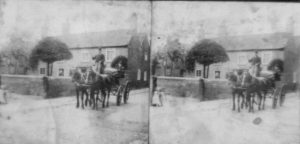
Morley’s, High Street, opposite the Co-op before 1900

Happy times: Announcement of the opening of the Dukeries Hotel, 1897 Mansfield Advertiser, 23rd July 1897 p5c1
Fire at the Dukeries Hotel, Edwinstowe, 1929 by John Farjeon
In the book “Edwinstowe Past & Present” compiled by the Edwinstowe Historical Society in 1987 (p.39) it is recorded that The Mansfield Brewery purchased the site of the hotel (just across from the railway station) in 1895 for £543. The licence was granted at the Retford Quarter sessions on 21st October 1896, and the hotel was built in 1897. M.J. Jackson, meanwhile, in his book “Edwinstowe: the Story of a Forest Village” (p32) says “The Dukeries Hotel, vast in comparison with other village hostelries, was built primarily to cater for those coming into the village by train and during the summer months the number of visitors was considerable”.
The Mansfield Advertiser (18th September 1896, p3 c3) recorded that, “With a view to providing further hotel accommodation for the many thousands of visitors to ‘The Dukeries’, the Mansfield Brewery Company are (sic) erecting at Edwinstowe, on a site on the opposite side of the main road… to the Derbyshire and East Coast Railway Co.’s new line, a magnificent family hotel and refreshment rooms combined”.
It said the hotel would cost about £7,000 to build, and that the architect was Mr. R. Frank Vallance F.R.I.B.A. of Mansfield.
The paper continued with a detailed description of the exterior and interior:-
Outside: “A picturesque style of architecture has been adopted as best suited to harmonize with famous woodland scenery. The lower part of the structure will be faced with Leicestershire red sand faced pressed bricks, relieved by white Mansfield stone dressings, and the upper portion will be constructed half-timber with cement panels.
The principal entrance to the hotel is through an open timbered porch, above which is an overhanging gable in timber. The roofs will be covered with red Staffordshire tiles and ornamental ridging of a suitable character”.
Inside : “[It will contain] on the ground floor, coffee room,, private sitting rooms, billiard and smoke rooms, sitting room and office for the manager, refreshment room, bar parlour, pavilion 51 feet by 24 feet, surrounded by a veranda, suitable for large assemblies and dancing, cloak rooms, lavatories, W.C.s, kitchens, scullery, larders, and other necessary offices.
The first floor contains further sitting room accommodation, large drawing room, numerous spacious bed-rooms, bathroom, lavatories, etc. etc. The second floor comprises additional bedroom accommodation, stores and tank room for storing water for domestic purposes and fir use in case of fire. Spacious beer and wine cellars are also provided under the central portion of the building. Behind the main buildings commodious stables and coach-houses are arranged, and the remaining part of the site will be laid out as pleasure grounds, with tennis courts etc.”
Looking at Trade directories, in 1912 and 1916 the manageress was Miss Charlotte Fox. The next available directory – 1922 – then lists Edgar Handley Hind as proprietor. Hind appears again in the 1925 directory, but by 1928 has been superseded by H. Snaith. Then, in early 1929, disaster stuck
On 22nd February 1929 The Mansfield Advertiser reported (p.6) “Destructive Fire at Edwinstowe: Well-known hotel practically destroyed: £12,000 – £15,000 damage”. The article went on:-
“One of the most destructive fires in the Mansfield area in recent years occurred in the early hours of Tuesday morning, involving the well-known Dukeries Hotel at Edwinstowe. More than one-half of the building was destroyed, and the portion remaining has suffered considerable damage from fire and water. The total damage is placed at between £12,000 and £15,000. The story of the discovery of the fire was related to a representative of the ‘Advertiser’ by Mr E.H. Edwards, who occupies a shop immediately opposite the hotel. About 3.30 on Tuesday morning, stated Mr Edwards, his Alsatian dog jumped on to his bed and aroused him, and as the animal continued restless he got up and came into the shop, and on looking through the window saw the pavilion adjoining the hotel a mass of flames and smoke and flames were also pouring out of the bedrooms at that end of the hotel. He then went to arouse the inmates of the hotel, all of who were sleeping at the opposite end from the fire, but whose rooms were beginning to fill with smoke. Mr Edwards summoned the Mansfield Fire Brigade by telephone, and also Mr P. Morley, captain of the Edwinstowe Brigade, but the latter were handicapped from getting to work on the blazing building owing to the hydrants being frozen up. The call was received at the Mansfield Fire Station at 4.15, and the brigade, under Captain A. Colbert, with two engines, arrived on the scene at 4.47. ‘It looked an almost hopeless task,” said Capt. Colbert, ‘when we arrived’. Some delay was experienced before the engines could be got to work owing to the stream from which water was pumped having to be cleared to immerse the suction. In order to cope with the fire the Mansfield brigade had to couple up forty lengths of hose, and the large engine was pumping water from the stream nearly a quarter of a mile away from the scene of the fire, for seven hours at the rate of 400 gallons per minute and giving a pressure from the jets of 120lbs. to the square inch. After nearly five hours’ work the firemen began to get the mastery of the flames, but it was not until four o’clock on Tuesday afternoon that the Mansfield Brigade was able to leave Edwinstowe. At mid-day spurts of flame were still to be seen shooting out from various parts of the ruins. The fire broke out again during Tuesday night among the rafters in that portion of the building which had been saved. The local brigade, fortunately, were still on duty and were able to extinguish the outbreak.”
The Dukeries Hotel is the property of the Mansfield Brewery Company, and was occupied by Mr. and Mrs. H. Snaith, a daughter and son-in-law of Mr. F. Oliver of the Dial Hotel, Mansfield. During Tuesday morning Mr Snaith was overcome by the shock of the affair and was removed to Mansfield.
“The origin of the fire is unknown, but it is believed to have originated in the neighbourhood of the vaults, and reaching the pavilion adjoining quickly destroyed the building….”
After that, the next directory I could find (1932) lists Cameron Rice as proprietor.
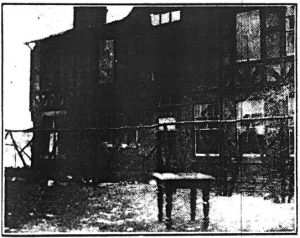
Damage caused by the fire, 1929

A Dennis open bodied ‘Braidwood’ Fire Engine was in service at Edwinstowe from around 1915. It carried a crew of 6 men. The engine at Edwinstowe was called ‘Mona’.

Fire Engine ‘Mona’ in 1930s with crew.

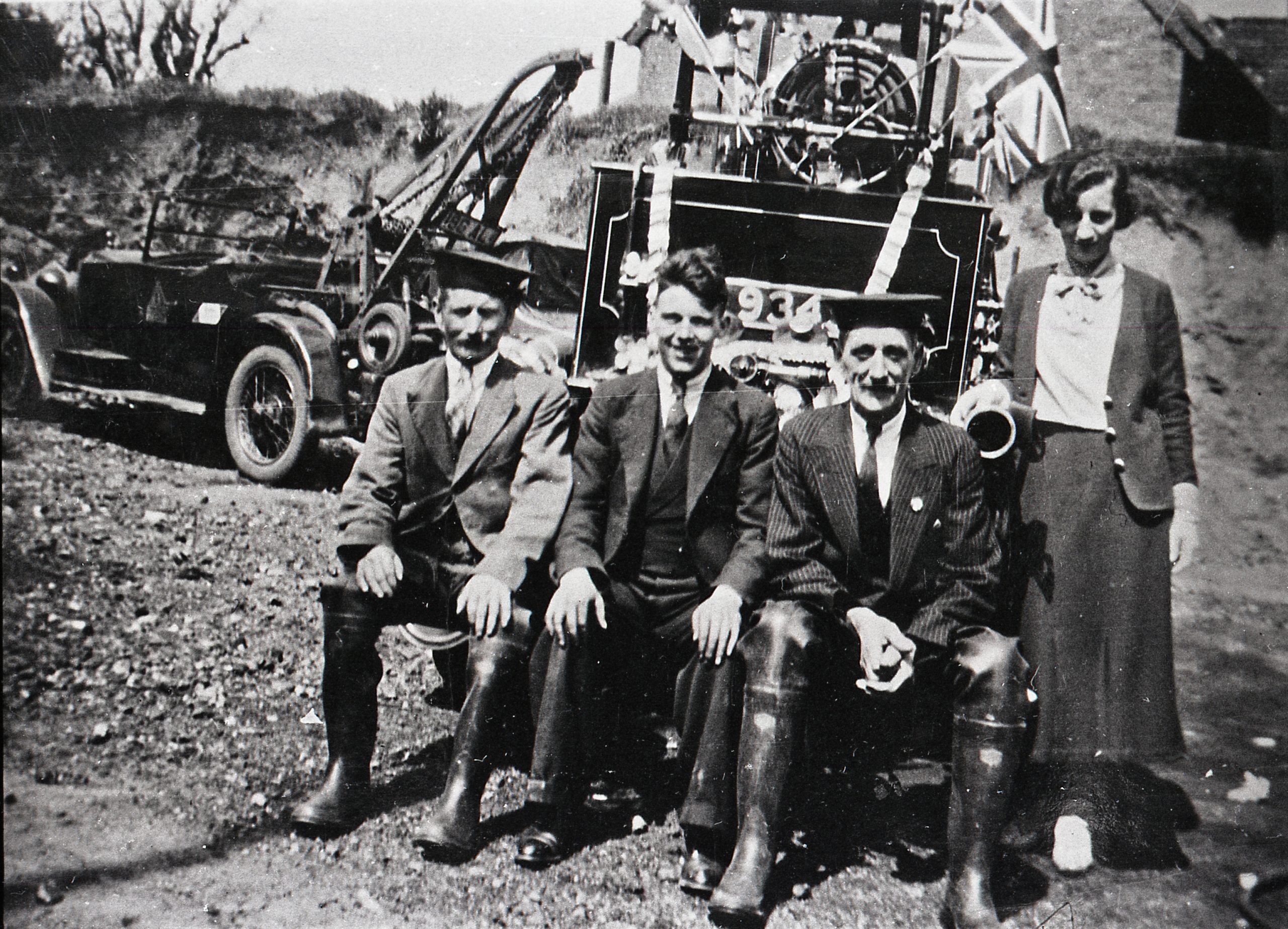



Fire at the Methodist Chapel, High Street, Edwinstowe
On a sunny Sunday afternoon in the early 1940s (thought to be ‘41 or ’42), the Fire Brigade was called out to a fire at the Chapel at about 4 p.m. after the children from the Sunday School had gone home.
‘Mona’, the fire engine, was rarely seen outside. When the Firemen tried to get her out the engine would not start. Meanwhile, the fire had developed and smoke was billowing from the roof of the Chapel. A decision on what to do had to be made quickly!
The Firemen pushed ‘Mona’ out of the engine house, situated at the bottom of West Lane, and on to the High Street. ‘Mona’ was seen to be huge; the biggest thing on road wheels solid tyres. The Fire Engine was bigger than the steam powered truck used to haul full length tree trunks up the High Street, taking up the whole width, towards Rufford Saw Mill.
Bystanders were recruited to help push ‘Mona’ up the High Street, past the scene of the fire, to turn her round at the crossroads, then push her downhill, past the scene of the fire for a second time, in order to bump start the engine. This was successful so she was driven to Mill Lane turned around and the tanks were filled with water from the River Maun. ‘Mona’ was then driven up the High Street, past the burning Chapel for a third time, turned around at the crossroads, thus facing downhill in case of an engine stall. Pews were seen floating in the water used to extinguish the fire and ‘water was cascading down the Chapel steps like Niagara Falls’.
The Chapel, though damaged, survived, as did the organ. This story was told to Michael Hayes largely by Percy Revill of 33, Fifth Avenue, who was a Fireman serving in the Edwinstowe Fire Brigade at the time of the fire.
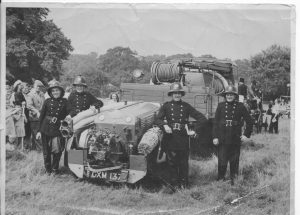
1950s
The photo shows Fred Brown a village fireman. This photo was probably taken in the 1950s at one of the many village events held at that time on the forest. It shows reading left to right, Les Briggs, ……?………., Alf Brocklehurst, and Fred Brown on parade with a somewhat antiquated contraption, (compared with today’s modern fire engines) used to fight fires during that time. Mr. Jim Mason and Mrs. Jennings are standing at the far left of the picture, watching the parade.

The present fire-station opened in 1958. It has one water tender and a crew of 18 retained (part timer) firemen. The men trained for 2 hours a week.

Back row: John Robinson, ? Dennis Taylor, Jack Hall,
Front row: Frank Crossland (Deceased), Victor Norgate, John Winfield.
Members of the Thoresby underground team.
Frank Crossland, a retired miner, who lives on Lansbury Road and has vivid memories of his service with Edwinstowe Fire Brigade which is stationed at the top of West Lane and, in Frank’s time as a fireman, was commanded by Sub-officer Jack Hall.
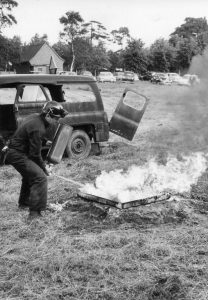 Mr. Anderson, was General Manager at the time and he was keen for Thoresby to enter a team in a regional fire-fighting competition. He asked Jack to select five fire-fighters to represent Thoresby and they were given a full week to prepare for the event on the pit top. The team, which included Frank, practiced again and again the various elements of the competition until they became really efficient. On the morning of the competition, a Saturday in June, 1969, the team endured a thorough rehearsal, before taking part in the competition, which had attracted about twenty teams from the East Midlands and was held in the field adjoining the N.C.B. Offices. In a close contest Thoresby achieved second position, losing to the eventual winners by a narrow margin.
Mr. Anderson, was General Manager at the time and he was keen for Thoresby to enter a team in a regional fire-fighting competition. He asked Jack to select five fire-fighters to represent Thoresby and they were given a full week to prepare for the event on the pit top. The team, which included Frank, practiced again and again the various elements of the competition until they became really efficient. On the morning of the competition, a Saturday in June, 1969, the team endured a thorough rehearsal, before taking part in the competition, which had attracted about twenty teams from the East Midlands and was held in the field adjoining the N.C.B. Offices. In a close contest Thoresby achieved second position, losing to the eventual winners by a narrow margin.
The British Coal North Area Firefighting Competition 1970s
The British Coal, North Notts. Area Office was located in the Edwinstowe House complex, between the bottom of the High street and the River Maun.
Each of the 15 collieries in the Area had its own fire-fighting team, and in order to judge their efficiency, an inter-colliery competition was held each year. Competition was strong between the collieries and the Thoresby team had their own competition during the week before the main event.
The competition was organised by the Area Safety Branch and held on the field below the Area offices, on a Saturday morning in mid-summer.
During the competition, petrol fires were lit in large steel trays and each team had to collect fire extinguishers and douse the fire with foam. In a second test, they had to run out a series of hoses, couple them, fit a nozzle and spray water on the target.
The tests were awarded marks by two senior fire officers from the Edwinstowe office of the North Nots. Fire service, and these marks, together with the time taken to complete the tasks, was used to determine the overall winner.
A trophy was awarded to the winning team, and each of the two judges from the Fire service received a bottle of whisky as a reward for their attendance.
by Laurie Patterson
Mines Rescue Practice at the National Coal Board Headquarters
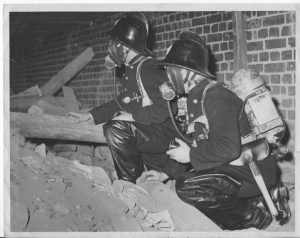
Practice Drill with Breathing Apparatus
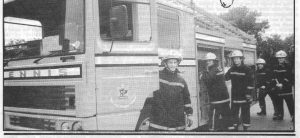
Reproduced below is an article from The Acorn summer edition 1995:
Have you heard of F Troup, J J Heroes or Fred Carno’s army, if not I’ll tell you a tale or two of the clowns that drive J J. Barmy.

The Firemen’s Poem
In the last edition of the Acorn we included this poem by an unknown fireman, however, Colin Wyld contacted Acorn to say that the poem certainly brought back memories for him. He recognised the poem as one that he had written whilst serving as a fireman at the Edwinstowe Fire Station. Colin said, ‘he would often put pen to paper for the annual Firemen’s Dinner’.

Present Edwinstowe Fire Station on Mansfield Road
 Edwinstowe Historical Society
Edwinstowe Historical Society